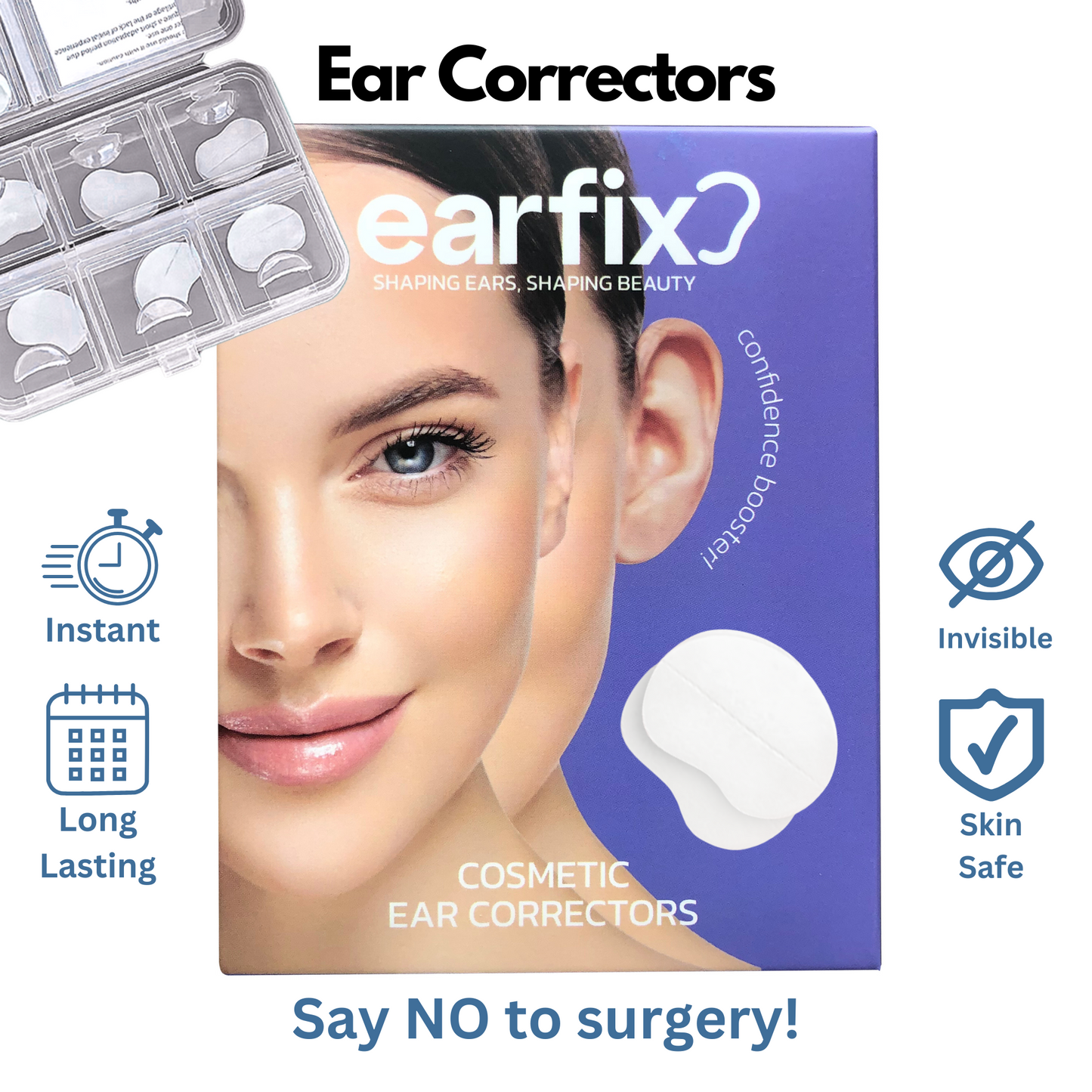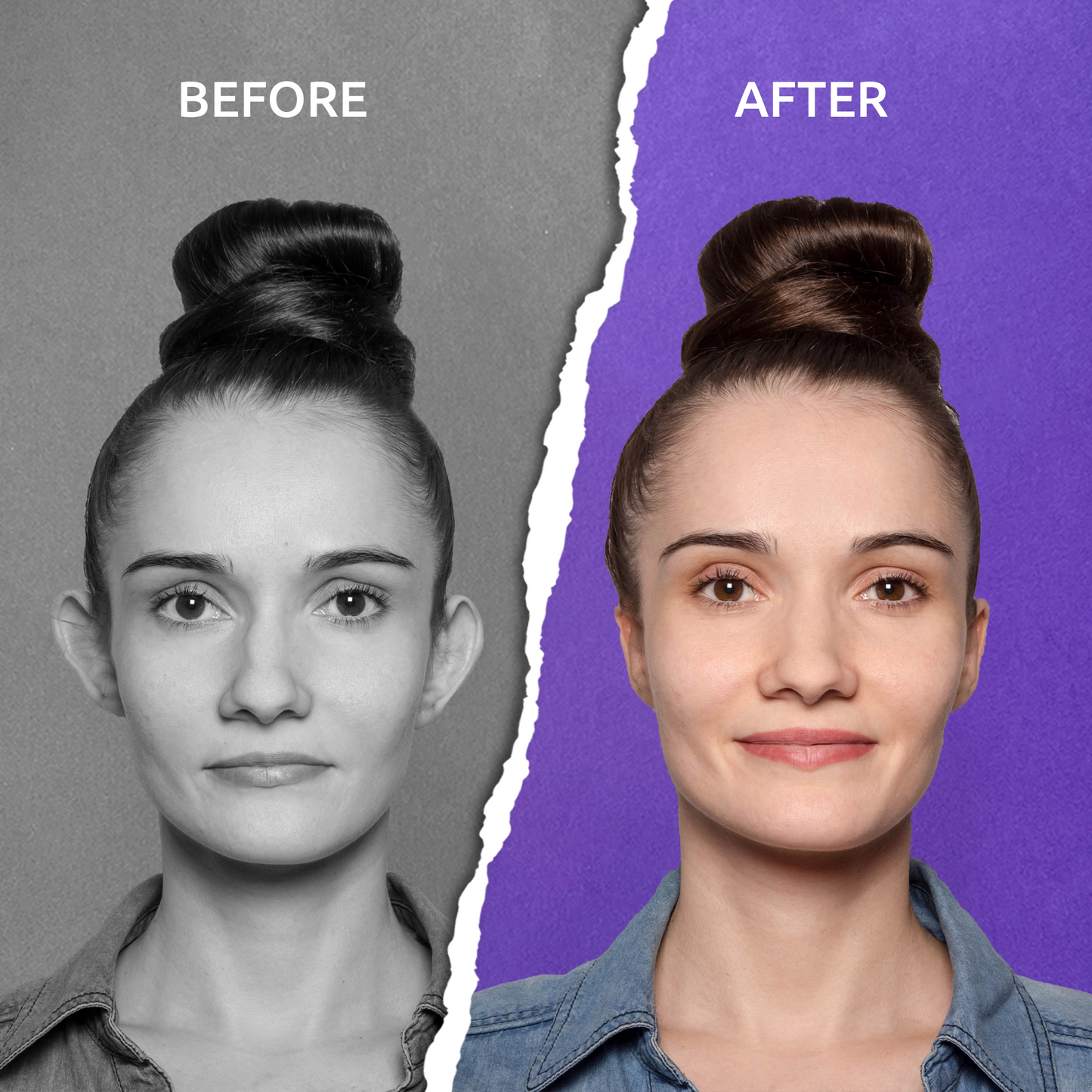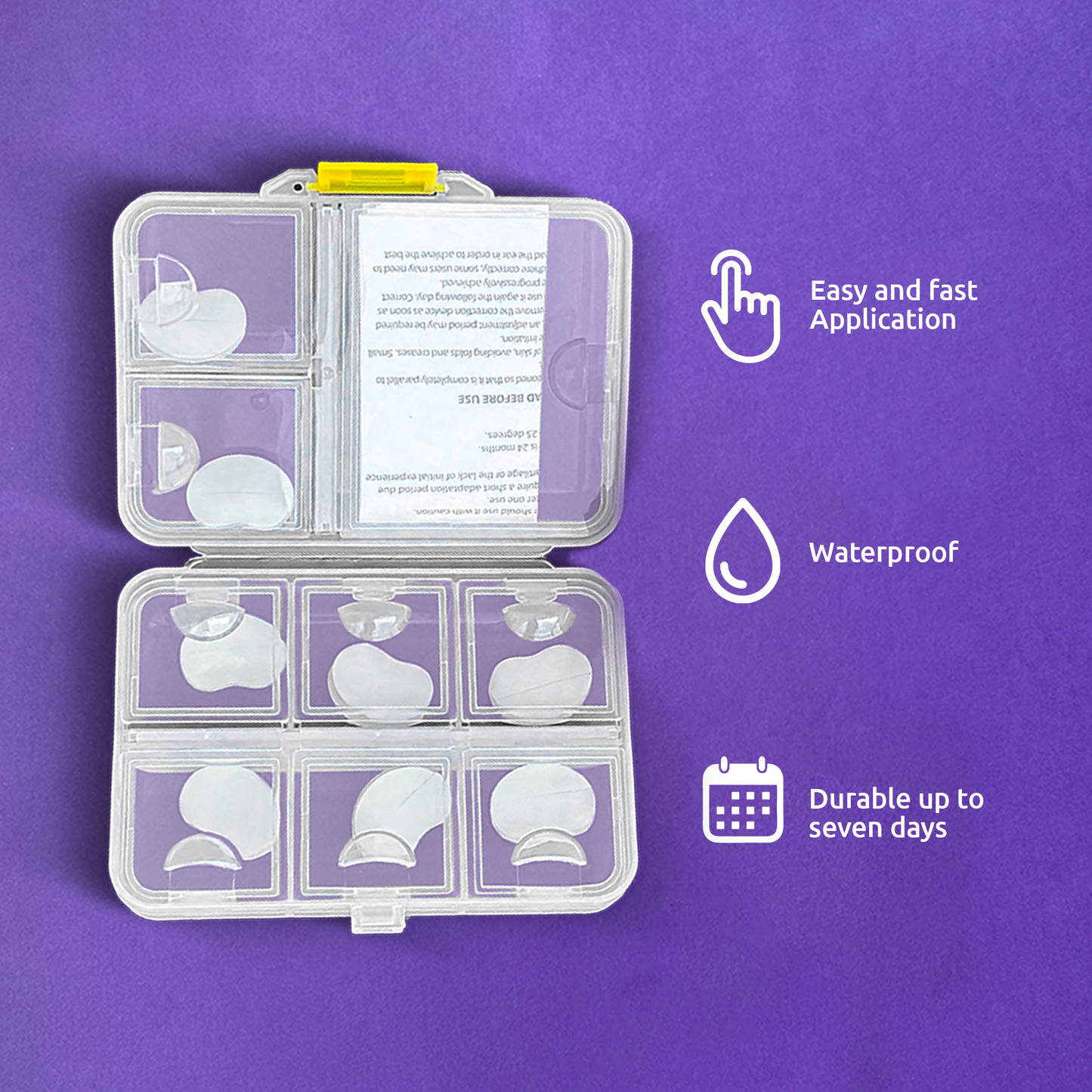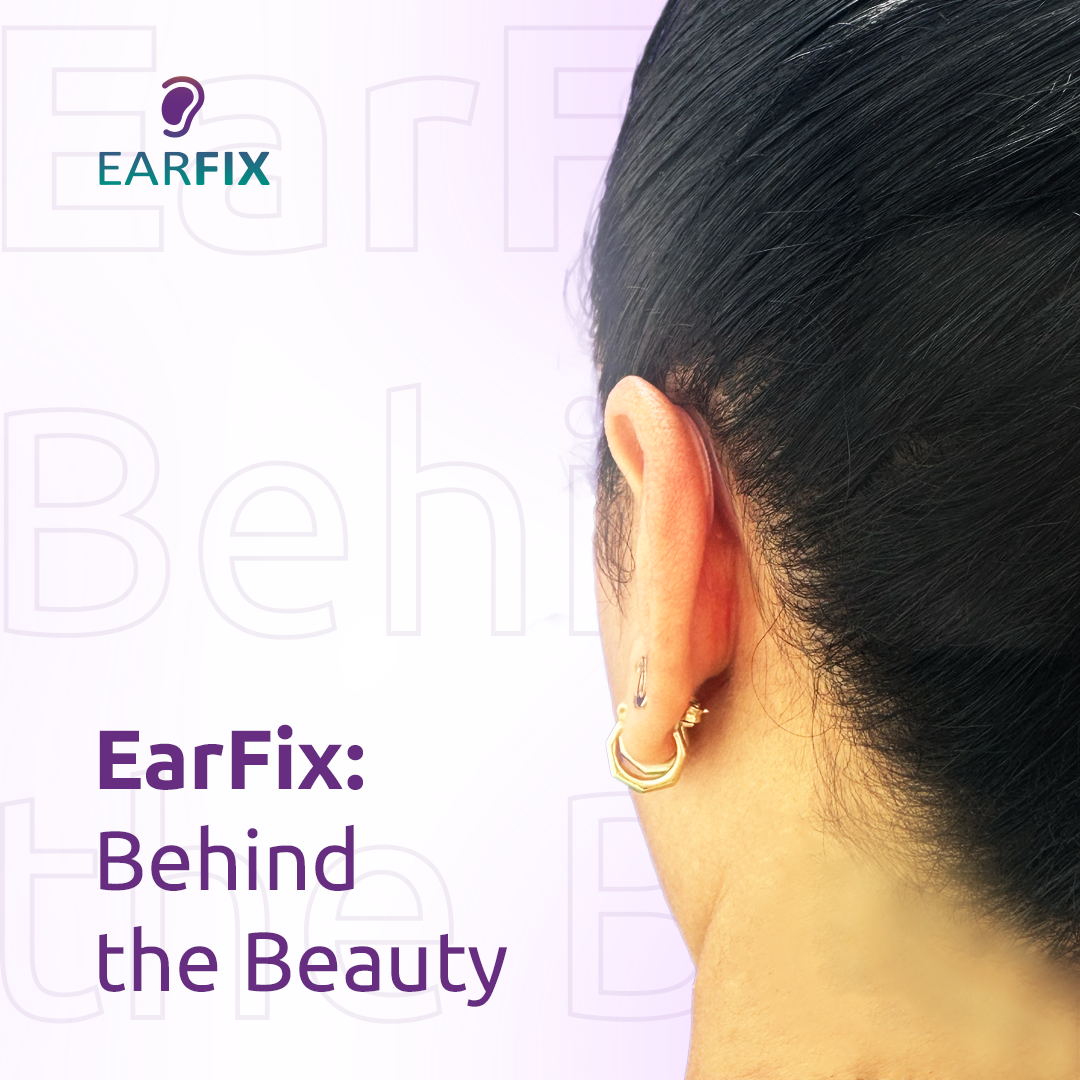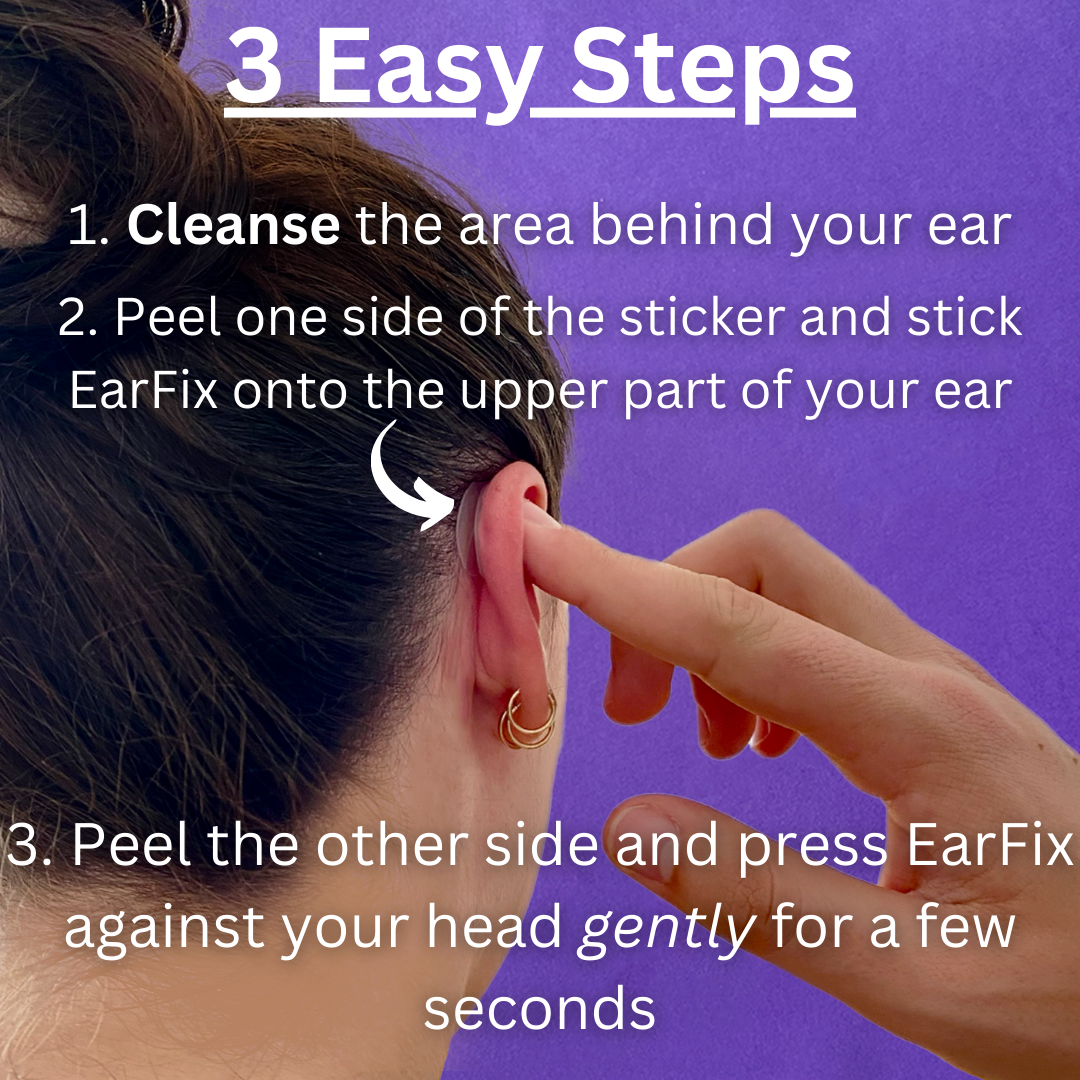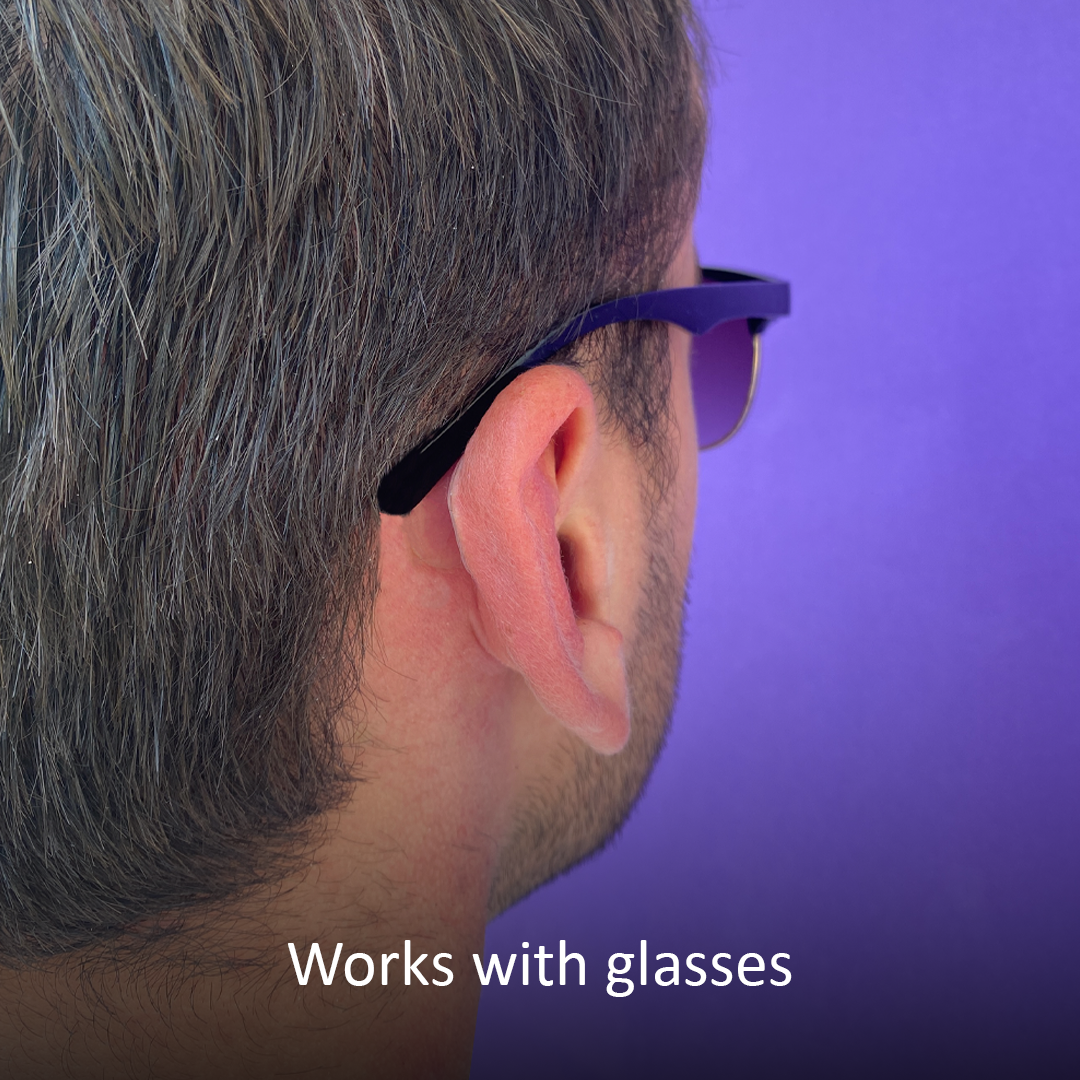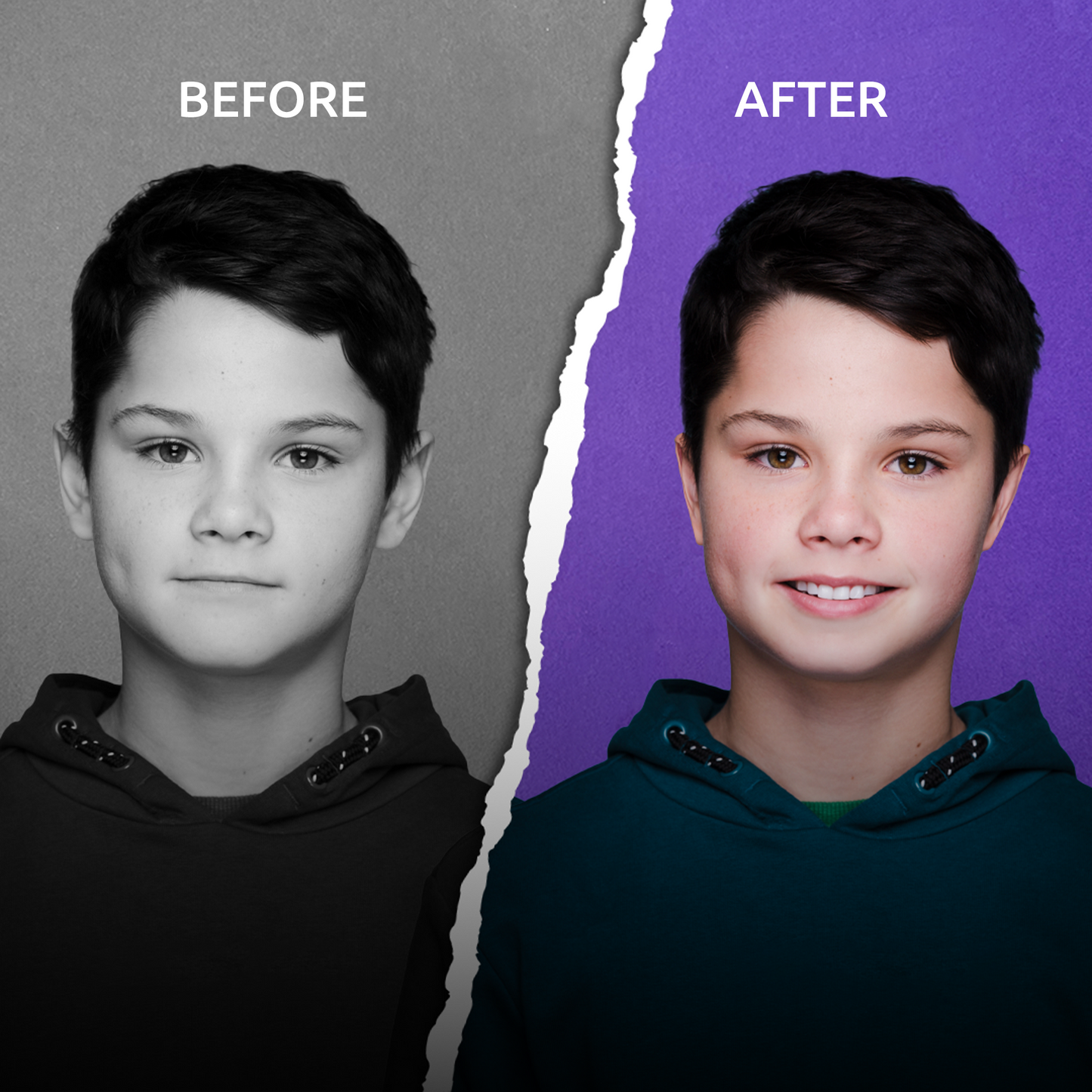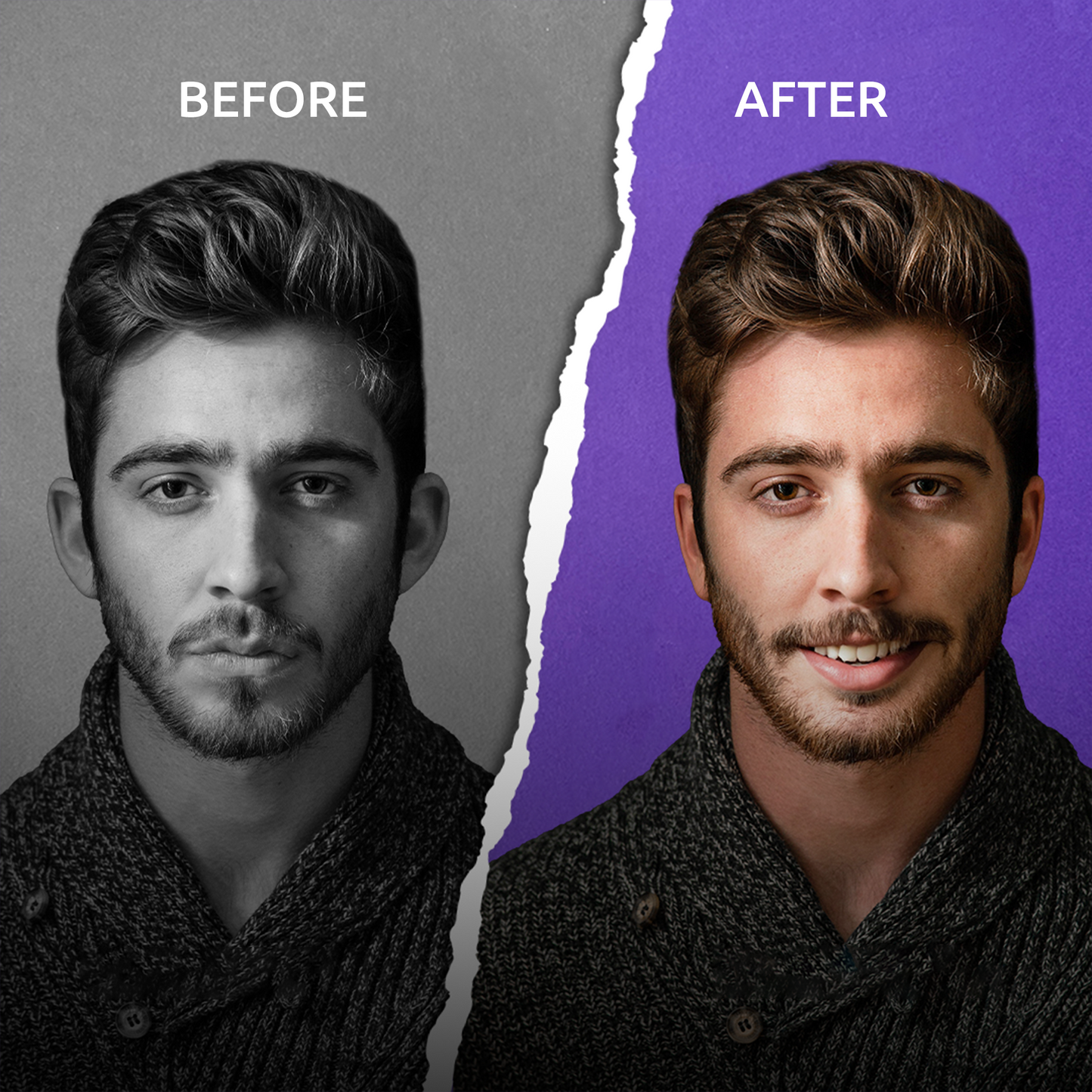Let's be honest, seeing yourself on camera can feel awkward. It's a feeling most of us know well. But here's the thing: your on-screen presence isn't set in stone. It's a skill, and like any skill, you can learn it.
Knowing how to look better on camera really just comes down to a few key fundamentals: mastering light, finding flattering angles, and projecting confidence. This guide will give you actionable advice to feel and look your best, whether you're hopping on a work call or just snapping a quick photo.
Why Looking Great On Camera Is a Learnable Skill
So many people think that looking good on camera is some kind of natural talent reserved for models and actors. The truth? It’s really just a series of small, practical adjustments that anyone can master. This isn't about dropping a ton of cash on expensive gear; it's about understanding the core principles that make a real difference.
We'll walk through the essentials for a great on-screen look, focusing on simple but powerful techniques. You'll quickly learn what separates an amateurish shot from a professional one by making easy changes to your environment and yourself.
A Discreet Solution for Camera-Shy Ears: Non-Surgical Otoplasty
One thing that doesn't get talked about enough is how small physical details can affect our confidence, especially in close-up shots. If you're conscious of prominent ears, feeling comfortable from every single angle is a huge deal. This is where a simple, non-surgical solution can completely change the game.
Products like EarFix offer an instant, pain-free way to get a more balanced profile. These medical-grade ear correction stickers are a fantastic alternative to otoplasty (ear surgery), giving you a temporary cosmetic improvement without the risks, long recovery, or high cost. As a discrete prominent ears solution, they let you focus on what you're saying, not on any insecurities.
If you're curious about how it stacks up against more invasive procedures, you can dive into the details in our EarFix vs Surgery article.
EarFix is designed for real life. It offers a secure yet gentle hold that’s perfect for daily wear, special events, or those all-important photoshoots. It’s all about enhancing your natural appearance to boost your inner confidence.
For parents, there’s even a baby ear corrector made with dermatologist-tested, hypoallergenic materials. It’s designed to gently and safely guide the cartilage in infants, making it a trusted choice for the littlest members of the family.
Ultimately, learning how to look better on camera is about feeling empowered. With the right techniques and tools, you can step in front of any lens feeling prepared and poised. Ready to see what a difference that confidence can make? You can explore EarFix products at earfixusa.com or find them on Amazon.
Mastering Light and Angles for a Flattering Look
If you want to know how to look better on camera, light and camera position are the two most powerful tools you have. Forget complicated setups; you can master both using exactly what you have right now. The simplest trick is to face a window, as natural light is soft, even, and incredibly flattering. It minimizes harsh shadows and gives your skin a healthy glow.
When natural light isn't an option, a simple ring light is a budget-friendly way to achieve a similar effect. It provides consistent, direct light that fills in shadows and makes you the clear focus of the shot. These small investments can make a massive difference.
Finding Your Best Angle
Just as crucial as lighting is the angle of your camera. The golden rule? Position your camera at eye level or slightly above. This angle is universally flattering because it sharpens your jawline and makes your eyes appear more open and engaged.
Avoid the dreaded "up-the-nostril" shot at all costs by propping your laptop or phone on a stack of books. A low camera angle is rarely flattering and can create weird shadows and distortions. A simple adjustment in height is one of the easiest ways to instantly improve how you look.
This simple visual breaks down the key pillars of looking great on camera, starting with the technical stuff like light and angles.
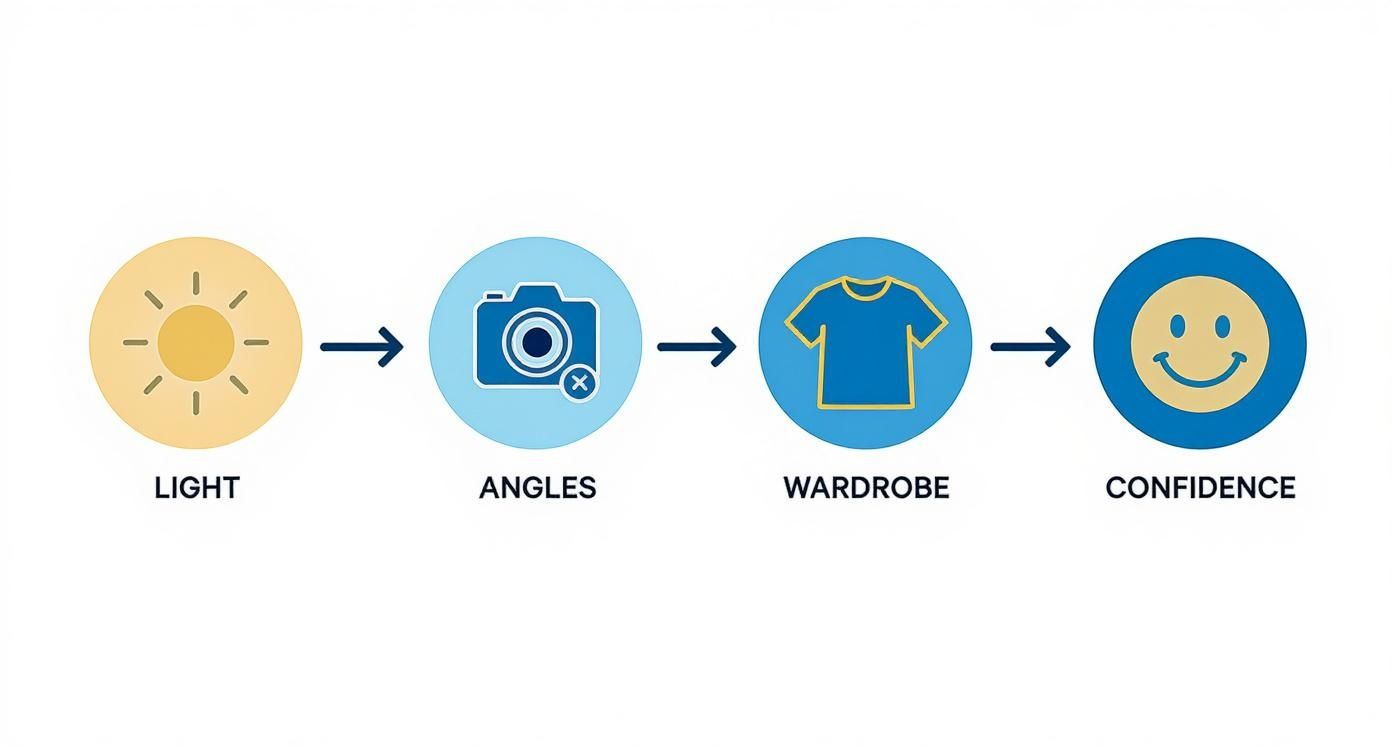
As you can see, a polished on-screen presence begins with technical elements like light and angles before moving on to personal elements like wardrobe and confidence.
Creating a Balanced Profile with Ear Correction Stickers
Angles are particularly important for your profile. If you feel self-conscious about prominent ears, the right camera position can help, but it doesn't solve the core issue of feeling comfortable from all sides. For a truly confident appearance, a non-surgical solution like EarFix can be a game-changer.
These discreet ear correction stickers offer an instant cosmetic improvement without the commitment or cost of surgery. They are a pain-free, non-invasive prominent ears solution that allows you to focus on your message, not your appearance.
"I used to constantly worry about how my ears looked during video calls. EarFix gave me the confidence to forget about that and just be myself. It's such a simple product, but the impact on my self-esteem has been huge."
For parents, it's reassuring to know there is a gentle baby ear corrector option available. Made from dermatologist-tested materials with gentle adhesion, EarFix for infants provides a safe way to address prominent ears early on. If you're wondering how this simple solution works, our guide on How to Use EarFix breaks it down step-by-step.
The Science of Good Lighting
Proper lighting isn’t just about being seen; it can fundamentally change your appearance. Good lighting can improve perceived skin tone, reduce the appearance of blemishes, and highlight your best features.
In fact, professional photographers report that about 85% of portrait quality hinges on the lighting setup alone. According to data from Great Big Photography World, using diffused, natural light sources reduces harsh shadows, potentially making you look up to 40% more attractive compared to a direct flash.
Ultimately, combining flattering light with the right camera angle creates a powerful foundation. Once you have these two elements locked in, you'll feel more prepared and confident every time you hit record. Want to see real-life examples? Check out our Customer Stories to see the difference for yourself.
Choosing a Camera-Ready Wardrobe and Look
What you wear on camera does more than just cover you up—it sends a message. While your words are the star of the show, your clothing and overall appearance set the visual tone. The trick is to pick something that feels like you, but a polished, confident, ready-for-the-screen version of you.
Honestly, the simplest choices are almost always the best. Solid, jewel-toned colors are a fantastic go-to. Think emerald green, sapphire blue, or a deep, rich red. These shades are flattering on nearly every skin tone, add a sophisticated pop of color without being loud, and help you stand out from your background.
What to Avoid in Your On-Screen Wardrobe
On the flip side, some patterns and colors can actively work against you. Super busy patterns, like tight pinstripes or complex plaids, can create a bizarre shimmering effect called moiré. It’s where the camera’s sensor gets confused by the lines, and trust me, it’s distracting.
Stark white can also be a problem, often blowing out the highlights and making you look like a floating head. Solid black can be just as tricky, causing you to lose all the details and contours in the shadows.
Polishing Your Look with Simple Grooming
Your clothing is a big piece of the puzzle, but so is your grooming. Little touches make a huge difference. High-definition cameras pick up everything, so taming flyaway hairs with a touch of hairspray or smoothing cream can instantly make you look more put-together.
Your on-screen look is about more than just clothes—it's about presenting a cohesive, confident version of yourself. When you feel good about how you look, from your outfit to your hairstyle, that confidence naturally shines through to your audience.
If you wear makeup, the camera tends to wash you out under bright lights. The goal isn't to mask your features, but to enhance them. A bit of concealer can work wonders for evening out skin tone, and a touch of blush adds back the warmth and dimension that harsh lighting can steal away. Keep it natural and true to your style.
Hairstyles play a surprisingly big role, especially in any shots that aren't straight-on. If you have prominent ears and love wearing your hair up or in a short style, feeling confident from every angle is key. This is where a discreet, non-surgical solution can be a game-changer, giving you the freedom to style your hair however you want without a second thought.
For some great ideas, check out our guide on hairstyles that complement every profile.
Ultimately, your wardrobe and grooming are there to support your message, not distract from it. When you feel polished and prepared, you can stop worrying about your appearance and focus on what really matters: connecting with your audience.
Let Your Confidence Shine Through: Posture and Presence
All the tech in the world—the fancy lights, the expensive camera—can't replace the human element. Your body language tells a story long before you even open your mouth. Mastering how you look on camera is really about learning how to project the confidence you already have.
It all starts with your posture. We've all heard "sit up straight," but on camera, it's non-negotiable. Good posture instantly signals that you're engaged and energetic. A simple trick is to imagine a string gently pulling the top of your head towards the ceiling. This naturally lengthens your spine. Now, roll your shoulders back and down. This opens up your chest, which not only looks more confident but physically helps you breathe deeper and stay calm.

Cultivating an Engaging Presence
With your posture set, try leaning in—just a tiny bit. This subtle forward motion bridges the gap between you and your audience, creating an immediate sense of connection. It's a small physical cue that says, "I'm here, and you have my full attention."
Your smile is another game-changer. But please, no forced, cheesy grins. We can all spot a fake smile from a mile away. Right before you go live or hit record, think of something that genuinely makes you happy or laugh. This will bring a natural light to your eyes and a warmth to your face that you just can't fake.
True on-screen confidence comes from feeling comfortable in your own skin. When you stop worrying about minor insecurities, you free up mental energy to focus on your message and connect authentically with your viewers.
Finding Confidence with a Non-Surgical Otoplasty Alternative
Let's be honest: sometimes, feeling confident takes a little extra help. If you've ever felt self-conscious about prominent ears, especially in profile shots or when your hair is tied back, you know how that one little thing can hijack your focus. This is where a simple, non-surgical solution like EarFix can make a massive difference.
These medical-grade ear correction stickers give you an instant, pain-free way to get a more balanced silhouette. Unlike invasive surgery, EarFix is a completely non-invasive prominent ears solution that’s affordable and has zero recovery time. You can learn more about how this discrete ear corrector provides both comfort and a huge confidence boost.
For parents, there's even a baby ear corrector version made with gentle, dermatologist-tested materials, offering a safe option for little ones.
Quick Relaxation Exercises
Feeling some pre-camera jitters? We've all been there. Try one of these quick exercises right before you start:
- Box Breathing: Breathe in for a count of four, hold for four, breathe out for four, and hold for four. Just a few rounds of this can work wonders to calm your nerves and center your mind.
- Shoulder Rolls: Slowly roll your shoulders up towards your ears, then back, and then down. This is a fantastic way to release all that tension that builds up in your neck and upper back.
These simple moves tell your body it's safe to relax, which allows your real personality to shine through on camera. When you feel good on the inside, you look poised and present on the outside.
Simple Camera Settings That Make a Big Difference
You don't have to be a tech wizard to get a better image out of your camera. Seriously. Most of the powerful tools you need are already built right into your smartphone or webcam. Just learning a few basic settings gives you a ton of control over how you look, making sure you always come across as polished and professional.
The big three you need to know are focus, exposure, and white balance. Focus keeps you sharp, exposure handles the brightness, and white balance makes sure your skin tone looks natural instead of orange or blue. Nailing these three is the foundation of a great shot.
Taking Control of Your Smartphone Camera
Here’s one of the best tricks in the book for smartphone users: lock your focus and exposure. Just tap and hold on your face on the screen. After a second, you’ll see an "AE/AF Lock" box pop up. This one little move stops your phone from annoyingly refocusing or changing the brightness every time you shift in your seat. The result? A smooth, consistent look for your entire video or call.
It's no surprise that smartphones are the go-to camera these days—they're used for about 85% of all photos taken annually worldwide. The AI built into modern phones is incredible, with some analyses showing that portrait modes can automatically boost perceived photogenic quality by 20-30%. This kind of tech puts powerful tools right in your pocket. You can learn more about how it's all evolving by checking out these smart camera market trends.
Create a Professional Look with Portrait Mode
Another game-changer is Portrait Mode. This feature uses software to artfully blur your background, which makes you stand out as the star of the show. It mimics that beautiful, shallow depth-of-field effect you see from expensive DSLR cameras. It’s perfect for hiding a messy room behind you or just creating a more cinematic, high-end feel.
Why a Balanced Look Matters
While camera settings handle the technical side, your personal confidence is what truly brings the image to life. If you’re constantly worried about how your ears look on camera, especially from a side angle, it can be a huge distraction. This is where a discreet, non-surgical solution can give you some much-needed peace of mind.
EarFix offers a simple way to get a more balanced profile without the expense or risk of surgery. These invisible ear correction stickers are a completely pain-free prominent ears solution, helping you feel comfortable from any angle. Think of it as a non-surgical otoplasty alternative designed for real life—they're comfortable, secure, and dermatologist-tested. There's even a gentle baby ear corrector for infants.
Feeling confident in your appearance allows you to forget the camera and just be yourself. When you're not worrying about insecurities, your genuine personality can shine, creating a much more engaging connection with your audience.
When you combine these simple camera tweaks with tools that boost your self-assurance, you've got a powerful formula for looking and feeling your absolute best on camera. Ready to feel more confident in your profile? You can explore EarFix at earfixusa.com or find it on Amazon today.
Your Last-Minute Checklist for a Flawless On-Screen Look
Before you hit "record" or join that video call, let's run through a quick pre-flight check. This isn't about chasing perfection; it's about being prepared so you can forget the small stuff and focus on what you have to say.
Think of this as your final confidence booster. It pulls together all the key tips we've covered and helps you sidestep that last-minute scramble. When you feel ready, you look ready.
5-Minute Pre-Camera Checklist
A quick scan of these key areas can make a world of difference. It only takes a couple of minutes to ensure you've covered all the essentials before the camera starts rolling.
| Check Area | Action Item | Why It Matters |
|---|---|---|
| Environment | Test your lighting by facing a window or turning on your main light source. | Good lighting is 85% of a great shot and minimizes harsh, distracting shadows. |
| Gear | Position your camera at eye level or slightly above. | This is the most universally flattering angle and helps create a direct, engaging connection. |
| Appearance | Wear a solid, jewel-toned color and do a quick check for flyaway hairs. | Simple, solid colors prevent weird camera distortion and keep the focus on you, not your outfit. |
The Final Confidence Check
At the end of the day, looking good on camera is really about feeling good on camera. If you find yourself distracted by prominent ears, a simple, non-surgical solution like EarFix can make all the difference.
These discreet ear correction stickers are a pain-free way to achieve a more balanced profile, letting your natural confidence shine through. This prominent ears solution is a fantastic alternative to surgery, offering immediate cosmetic improvement with zero downtime. For the little ones, the baby ear corrector version is made with gentle, dermatologist-tested materials for complete peace of mind.
Ready to feel confident from every angle? You can explore all our products at earfixusa.com.
Got Questions About Looking Good on Camera? We've Got Answers
Even after you've nailed the basics, a few specific questions always seem to pop up. Let's tackle some of the most common hurdles people run into when trying to get that perfect on-camera look.
What Camera Lens Is the Most Flattering?
The lens you choose can subtly (and sometimes not-so-subtly) change the proportions of your face. While today's smartphone cameras are incredibly powerful, nothing beats a dedicated prime lens with a fixed focal length for minimizing distortion and creating a flattering portrait.
There's a reason the global camera lens market was valued at USD 6.5 billion back in 2025—people are serious about getting high-quality images. Lenses around the 50mm mark are a worldwide favorite because they capture faces in a way that just feels natural and true-to-life. If you want to dive deeper, you can find more on the science behind lens choices at futuremarketinsights.com.
How Do I Stop My Photos From Looking Grainy?
That grainy look, often called "digital noise," is almost always a sign of shooting in low light with your camera's ISO cranked up too high. Think of ISO as your camera's sensitivity to light. Bumping it up lets you capture an image in a dark room, but the trade-off is often a loss in quality.
The easiest fix? Add more light. It's that simple. Open a curtain, bring a lamp closer, or use a ring light. By brightening your scene, you can keep the ISO low, which results in a much cleaner, sharper image.
What If I’m Still Self-Conscious About My Profile?
Feeling confident from every angle is a massive part of looking and feeling your best on camera. If you find yourself worried about how your ears look, especially from the side, a non-surgical solution can give you immediate peace of mind.
We put together a complete guide on how to fix ears that stick out that walks you through how a simple, discreet cosmetic corrector can make all the difference.
When you stop worrying about small insecurities, your genuine personality has a chance to shine through. That’s what people connect with, and that’s the real goal.
At EarFix USA, we believe confidence should be simple. Our discreet, pain-free ear correctors are designed to help you feel fantastic from every angle, so you can stop thinking about your appearance and start focusing on your message.
Ready to feel camera-confident? Explore our solutions at earfixusa.com or find us on Amazon.



